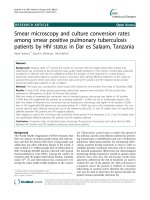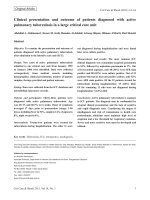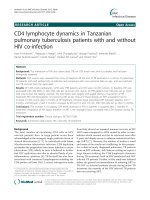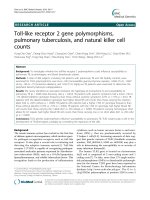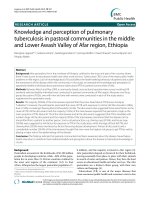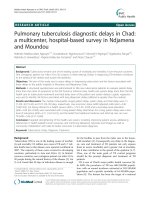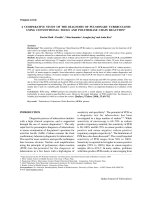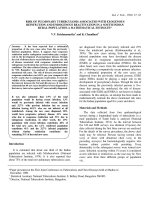Toll-like receptor 2 gene polymorphisms, pulmonary tuberculosis, and natural killer cell counts pot
Bạn đang xem bản rút gọn của tài liệu. Xem và tải ngay bản đầy đủ của tài liệu tại đây (867.54 KB, 10 trang )
RESEARC H ARTIC LE Open Access
Toll-like receptor 2 gene polymorphisms,
pulmonary tuberculosis, and natural killer cell
counts
Yung-Che Chen
1
, Chang-Chun Hsiao
2
, Chung-Jen Chen
3
, Chien-Hung Chin
1
, Shih-Feng Liu
1
, Chao-Chien Wu
1
,
Hock-Liew Eng
4
, Tung-Ying Chao
1
, Chia-Cheng Tsen
1
, Yi-Hsi Wang
1
, Meng-Chih Lin
1*
Abstract
Background: To investigate whether the toll-like receptor 2 polymorphisms could influence susceptibility to
pulmonary TB, its phenotypes, and blood lymphocyte subsets.
Methods: A total of 368 subjects, including 184 patients with pulmonary TB and 184 healthy controls, were
examined for TLR2 polymorphisms over locus -100 (microsatellite guanine-thymine repeats), -16934 (T>A), -15607
(A>G), -196 to -174 (insertion>deletion), and 1350 (T>C). Eighty-six TB patients were examined to determine the
peripheral blood lymphocyte subpopulations.
Results: We newly identified an association between the haplotype [A-G-(insertion)-T] and susceptibility to
pulmonary TB (p = 0.006, false discovery rate q = 0.072). TB patients with systemic symptoms had a lower -196 to
-174 deletion/deletion genotype frequency than those without systemic symptoms (5.7% vs. 17.7%; p = 0.01). TB
patients with the deletion/deletion genotype had higher blood NK cell counts than those carrying the insertion
allele (526 vs. 243.5 cells/μl, p = 0.009). TB patients with pleuritis had a higher 1350 CC genotype frequency than
those without pleuritis (12.5% vs. 2.1%; p = 0.004). TB patients with the 1350 CC genotype had higher blood NK
cell counts than those carrying the T allele (641 vs. 250 cells/μl, p = 0.004). TB patients carrying homozygous short
alleles for GT repeats had higher blood NK cell counts than those carrying one or no short allele (641 vs. 250 cells/
μl, p = 0.004).
Conclusions: TLR2 genetic polymorphisms influence susceptibility to pulmonary TB. TLR2 variants play a role in the
development of TB phenotypes, probably by controlling the expansion of NK cells.
Background
The innate i mmune system has evolved as the first line
of defense against microorganisms, which involves speci-
fic pathogen recognition receptors such as toll-like
receptors. It also plays a crucial role in initiating and
directing the adaptive immu ne system[1]. Toll-like
receptor 2 (TLR2) is capable of recognizing pathogen-
ass ocia ted molecular patterns expressed by Mycob acter-
ium tuberculosis (Mtb), such as a 19-kDa lipoprotein,
lipoarabinomannan, and soluble tuberculosis factor. This
recognition leads to the production of inflammatory
cytokines, such as tumor necrosis factor-a and inter-
feron (IFN)-g, that are predominantly secreted by
T-helper-1 cells[2-5]. Increasing amounts of data sug-
gest that genetic variants of TLR2 (GenBank accession
number, NM_003264.3; MIM no. 603028) may play a
role in determining the susceptibility to or severity of
many infectious diseases[6].
The human TLR2 gene is located on chromosome
4q32 and is composed of 2 non-coding exons and 1
coding exon[7]. To date, more than 175 single-nucleo-
tide polymorphisms (SNPs) or dinucleotide polymorph-
isms for the human TLR2 gene have been reported in
the National Center for Biotechnology Information
database . The G to A
(Arg753Gln) polymorphism at position 2258 in exon 3
* Correspondence:
1
Division of Pulmonary and Critical Care Medicine, Department of Internal
Medicine, Chang Gung Memorial Hospital-Kaohsiung Medical Center, Chang
Gung University College of Medicine, Kaohsiung, Taiwan
Chen et al. BMC Medical Genetics 2010, 11:17
/>© 2010 Chen et al; licensee BioMe d Central Ltd. This is an Open Access article distribute d under the terms of the Creative Commons
Attribution License ( which permits unrestricted use, distribution, and reproduction in
any medium, provided the original work is properly cited.
and the guanine-thymine (GT) microsatellite repeat
polymorphism (100 bp upstream of the translational
start site) in intron 2, have been associated with sus-
ceptibility to clinical tuberculosis (TB) disease in Turk-
ish and Korean patients, respectively[8,9]. Another 2
polymorphisms within the TLR2 promoter region,
namely, -16934 A>T and -196 to -174 insertion (Ins)
>deletion (Del), have been associated with asthma and
gastric cancer, respectively [10,11]. On the basis of the
International HapMap Project, 2 tag SNPs (-15607 A>G
and 1350 T>C) in the TLR2 region could be selected
with a r
2
cutoff of 0.8 for the Han Chinese in Beijing
using the algorithm-Tagger-pairwise Tagging[12,13].
Previous studies investigating the association between
TLR2 polym orphisms and diseases have targeted indivi-
dual genetic markers at a single locus[6,8-11,14]. An
alternative approach is to use haplotype structures that
are derived from allelic variants at a number of loci on
a chromosome. Although synonymous SNPs in the cod-
ing region of the TLR2 gene have been associated with
tuberculous meningitis in patients in Vietnam, there are
no reports of the association between variants of this
gene and the development of systemic symptoms of or
pleural involvement in pulmonary TB[14].
Expression of TLR2 in the human immune system is
most predominant in myelomonocytic cells, followed by
Bcells,CD56
+
16
+
cells, and T cells[ 15,16]. TLR2 is
implicated in the activation of CD3-CD56
+
natural killer
(NK) cells, which are a major source of early IFN-g in
tuberculous pleurisy[17]. It also directly controls the
expansion and function of regulatory T cells and i s
involved in mediating B cell differentiation[18,19]. T he
association between TLR2 polymorphisms and lympho-
cyte subsets has not yet been determined.
We hypothesized that (1) TLR2 m icrosatellite poly-
morphism or SNPs may predispose Taiwanese people to
pulmonar y TB; (2) TLR2 gene polymorphisms may pre-
dispose patients with pulmonary TB to presenting with
systemic symptoms or pleural involvement; and (3)
TLR2 gene polymorphisms may influence blood lym-
phocyte subsets. The aim of the present study was to
examine whether the genotypes defined by the 5 TLR2
gene polymorphisms located at -16934, -15607, -196 to
-174, -100, and 1350 influence susceptibility to pulmon-
ary TB, its clinical presentations, and peripheral blood
lymphocyte subsets at diagnosis.
Methods
Study subjects
The study population consisted of 184 patients with
newly diagnosed pulmonary TB, who were undergoing
anti-TB t reatment at the Pulmonary Department of the
Chang Gung Memorial Hospital (Kaohsiung, Taiwan)
during August 2006-July 2008. The specific criterion for
enrollment was defined as the presence of at least 1 of
the following: (1) clinical and radiol ogical findings indi-
cating pulmonary TB and at least 1 positive Mtb culture
from 3 separate sputum examinations or 1 bronchial
washing specimen obtained from bronchoscopy; (2)
pathological evidence of TB on pleural or lung mass
biopsy; and (3) clinical and radiological findings indicat-
ing improvement in suspected pulmonary TB with
empirical anti-TB therapy. Patients with acquired
immune deficiency syndrome or those receiving immu-
nosuppressive agents were excluded. The control group
consisted of 184 unrelated subjects recruited from the
Center of Health Examination of Chang Gung Memorial
Hospital (Kaohsiung, Taiwan). The specific criteria of
enrollment were the absence of pulmonary lesions on
chest radiographic examination and a negative history of
TB disease. All the subjects of both the study and con-
trol groups are residents in Taiwan, where new TB
cases per 100,000 populations were from 62.0 to 74.6 in
the p ast seven years. We assume that people in Taiwan
have similar expo sure to M.tb, because the modes of its
transmission are mainly through large droplets and
small particle droplet nuclei. This study was appr oved
by our institutional review board, and written informed
consents were obtained from all subjects before blood
sampling.
Molecular techniques and genotyping
Genomic DNA was isolated from blood leukocytes using
a genomic DNA purification kit (Puregene; Gentra sys-
tems, Minneapolis, Minnesota, USA). Genotyping was
performed according to the methods described pre-
viously, with some modifications[9,11]. The nucleotide
sequences of the primers used and the conditions for
polymerase chain reactions (PCR) are listed in Table 1.
Genotyping of the GT microsatellite repeat polymorphism
by gene scan
PCRs with 5-carboxy-fluorescein (FAM)-labeled primers
were carried out to amplify a region of about 250 bp
flanking the GT microsatellite repeat region. The num-
ber of GT repeats was estimated by calculating the
number of base pairs in the PCR products by using a
sequencer (ABI Prism®3100 Genetic Analyzer; Applied
Biosystems, USA) and Gene Scan analysis software.
T, -15607 A>G, 1350 T>C, and 2258 G>A polymorphisms
by direct sequencing",1,0,1,0,0pc,0pc,0pc,0pc>Genotyping
of the -16934 A>T, -15607 A>G, 1350 T>C, and 2258 G>A
polymorphisms by direct sequencing
Approximately 1 μg of sample DNA was added to a
reaction mixture containing 2.5 μl 10 × buffer, 2 μlof
each dNTP, 10 μmo l of each primer, and 1. 25 U of Taq
DNA polymerase (Pro Taq Plus DNA polymerase).
PCRs were carried out on a thermal cycler (Gen-
eAmp®PCR system 9700; Applied Biosystem, Foster City,
California, USA) under specific conditions and with
Chen et al. BMC Medical Genetics 2010, 11:17
/>Page 2 of 10
primers to amplify regions of 1492, 618, 392, and 265 bp
flanking the -1693 4 A>T, -1 5607 A>G, 135 0 T>C, and
2258 G>A polymorphism loci, respectively. Genotyping
was performed by sequence analysis of the PCR pro-
ducts using an ABI PRISM 3730 genetic analyzer
(Applied Biosystems, Darmstady, Germany). We did not
detect the 2258 G>A mutation in any subject in both
the groups.
deletion polymorphism by primer-specific
PCR",1,0,1,0,0pc,0pc,0pc,0pc>Genotyping of the -196 to
-174 insertion>deletion polymorphism by primer-specific
PCR
The volume of the PCR reaction mixture was 25 μl, and
the mixture contained 1 μggenomicDNA,10μmol of
each primer, 2 μl of each dNTP, and 1.25 U of Taq
DNA polymerase. The PCR products were visualized by
electrophoresis on a 3.5% agarose gel and stained with
ethidium bromide. A single band at 286 bp was judged
to be the wild-type product; a single band at 264 bp, a
homozygote variant; and 2 bands at 286 and 264 bp, a
heterozygote variant.
Determination of blood lymphocyte phenotypes by flow
cytometry
To evaluate the expression of surface markers on freshly
isolated peripheral blood mononuclear cells from 86 TB
patients within 2 weeks of anti-TB treatment, we used
fluorochrome-labeled monoclonal antibodies: anti-CD3-
phycoerythrin (PE), CD4-fluorescein isothiocyanate
(FITC), CD8-FITC, CD19-FITC, and CD56
+
16-FITC.
All the antibodies were purchased from Beckman Coul-
ter (Marseille, France). Acquisition was performed on a
FACScalibur Flow Cytometer (Becton Dickinson, San
Jose, California, USA), and 2 × 10
4
lymphocyte-gated
events were collected according to their forward and
side-scatter properties. These were further analyzed for
the expression of CD3 and CD4 (or CD8, CD19, and
CD56
+
16) in the FL1 and FL2 channels, respectively.
The analysis of the data was performed using the Simul-
SET software. Absolute cell count was com puted from
the lymphocyte percentage of the differential white
blood cell count.
Statistical analysis
Deviation from the Hardy-Weinberg equilibrium was
tested using a c
2
goodness of fit test for each locus in
each cohort. The global association between case-con-
trol status and each allele of GT repeat microsatellite
polymorphism was tested using a likelihood ratio. The
differences in allele frequencies and genotype distribu-
tion between the 2 groups were evaluated by a c
2
test,
and the odds ratios (OR) were calculated with a 95%
confidence interval (CI). Pairwise linkage disequi librium
(LD) among the 4 non-microsatellite polymorphisms in
the study population was measured by calculating the r
2
and D’ statistics. LD blocks were defined on the basis of
the internally developed solid spine method, which
searches for a “spine” of strong LD running from one
marker to another along the legs of the triangle in the
LD chart, and the haplotype frequencies were estimated
using the expectation-maximization algorithm with the
Haploview software[12,13]. Haplotype coun ts for case-
control a ssociation tests were obtained by summing the
fractional likelihood of each individual for each haplo-
type. All te sts were 2-tailed, and p < 0.05 was consid-
ered as significant. To assist in the interpretation of
p-values given the number of statistical tests performed,
false discovery rate q-values were calculated separately
for single marker polymorphism and haplotype analyses.
The q value estimates the proportion of results declared
Table 1 Biological characteristics of the genotyped TLR2 polymorphisms and the primers and conditions used for PCR
Polymorphism
(DNA position
relative to ATG)
rs number Primers and conditions for PCR
-100 (GT)n rs34692294 Forward:
ionhs5’-GCATTGCTGAATGTATCAGGGA-3’
Reverse:
5’-CCACAAAGTATGTGCCATGGTCCAGTGCTTC-3’
Condition: 95°C, 3 min; (95°C, 30 sec; 55°C, 30 sec; 72°C, 1 min) × 35 cycles; 60°C, 60 min
-16934 A>T rs4696480 Forward: 5’-TGGTTCTGGAGTCTGGGAAG-3’
Reverse: 5’-ACAGAACGGTCTCCAAGTAG-3’
Condition: 94°C, 5 min; (94.1°C, 1 min; 59.3°C, 1 min; 72.2°C, 2 min)× 35 cycles; 72°C, 10 min.
-15607 A>G rs1898830 Forward: 5’-GCAGCTGAAATCACAGAGCA
Reverse: 5’-AGGATAATGGCCTCCTGCT
Condition: 94°C, 5 min; (94°C,1 min; 67.1°C,40 sec; 72°C,2 min) × 30 cycle; 72°C, 10 min
-196 to -174
Ins>del
not available Forward: 5’-cacggaggcagcgagaaa
Reverse: 5’-ctgggccgtgcaaagaag
Condition: 94°C, 5 min; (94°C,1 min; 64.5°C,1 min; 72°C,2 min) × 35 cycle; 72°C, 10 min
1350 T>C
(S450S)
rs3804100 Forward: 5’-AACCGGAGAGACTTTGCTCA
Reverse: 5’-AGTTATTGCCACCAGCTTCC
Condition: 94°C, 5 min; (94°C,40 sec; 62°C,40 sec; 72°C,1 min) × 30 cycle; 72°C, 10 min
Chen et al. BMC Medical Genetics 2010, 11:17
/>Page 3 of 10
interesting that are actually false. A q value threshold of
0.2 was selected to separate false from true discoveries,
so up to 20% of declared discoveries should be expected
to be false [20,21].
Thedifferenceinthegenotypic distribution between
the TB phenotypes was evaluated in a dominant model
by a c
2
test in which the wild-type and heterozygote
variant were compared with the homozygote variant,
because the data fit the dominant model better than
other models of inheritance, such a s recessive and het-
erozygous advantage. Continuous variables between the
2 groups were analyzed by a Mann-Whitney U-test or
independent T test, where appropriate.
Results
Demographics of the participants
Characteristic s of cases and controls are listed in Table 2.
The study population was all Asian in ethnicity. Age and
male sex ratio were similar between the 2 groups. Tradi-
tional acquired risk factors, such as history of diabetes
mellitus, malignancy, chronic bronchitis, and chronic
renal insufficiency were more common in cases than in
controls. Microbio logical diagnosis was made in 142
(77.2%) TB patients; pathological diagnosis was made in
27 (14.7%), and clinical diagnosis was made in 15 (8.1%).
Allele and genotype frequencies in TB patients and
healthy controls
The genotype frequency distribution for all the 5 poly-
morphisms investigated was consistent with the Hardy-
Weinberg equilibrium in the patients and control groups
except for -16934A>T in the control cohort (p = 0.005).
The allele frequencies of GT repeats between the 2
groups are summarized in Table 3. GT microsatellite
polymorphism had no significant global association with
risk of pulmonary TB (Likelihood Ratio 26.17, p = 0.052).
When each allele was analyzed independently and the
ones with minor allele frequency o f < 5% was pooled
together, no individual GT repeat alleles were associated
with susceptibility to pulmonary TB. The overall distribu-
tions of short allele (S, number of GT repeats ≦ 16), mid-
dle allele (M, number of GT repeats = 17-22), and long
allele (L, number of GT repeats ≧ 23) were not signifi-
cant ly differ ent between the patients and control groups.
No significant difference was observed individually
between the patient and the control groups with respect
to the allele or genotype frequency f or the other four
polymorphisms (Table 4).
Association of TLR2 haplotype with pulmonary TB
Figure 1 shows a graphical representation of LD
between the loci of the four non-microsatellite poly-
morphisms. The physical distance between polymorph-
isms -16934 A>T and 1350 T>C on chromosome 4 is
approximately 17 kb. Moderate LD was observed among
the four polymorphisms (D’ > 0.5). Using the 4 non-
microsatellite polymorphisms, haplotype frequencies
were estimated by the Haploview software. Haplotype
[A-G-(Ins)-T] was associated with susceptibility to pul-
monary TB (OR, 1.99; 95% CI, 1.21-3.25; p = 0.006,
q = 0.072) (Table 5).
Associations between the -196 to -174 Del/Del and 1350
CC genotypes with TB phenotypes
When TB patients were divided i nto those with (105/
184) or without (79/184) systemic symptoms, including
fever, weight loss, or anorexia, the only significant differ-
ence between the 2 subgroups was with respect to the
-196 to -174 Ins>Del polymorphism. TB patients with
systemic symptoms had a significantly lower Del/Del
genotype frequency than those without systemic symp-
toms (5.7% vs. 17.7%; OR, 0.28; 95% CI, 0.1-0.77;
p = 0.01). When t he patients with pulmonary TB wer e
divided into those with (40/184) or without (144/184)
pleural involvement, defined as the presence of pleural
effusion on chest X-ray (CXR), the only significant dif-
ference between the 2 subgroups was with respect to
the 1350 T to C SNP. TB patients with pleural effusions
had a significantly higher 1350 CC genotype frequency
than those without pleural effusions (12.5% vs. 2.1%;
OR, 6.71; 95% CI, 1.53-29.45; p = 0.004) (Table 6.).
Associations between the TLR2 genotypes and blood
absolute NK cell counts in TB patients
TB patients carrying homozygous S alleles had higher
blood absolute NK cell counts compared with those
Table 2 Characteristics of Study Participants
Characteristic TB Cases
(n = 184)
Controls
(n = 184)
P value
Age, mean ± standard deviation, years 56.7 ± 18.7 53.9 ± 11.5 0.082
Male, n (%) 133 (72.3) 122 (66.3) 0.214
Diabetes Mellitus, n (%) 37 (20.2) 11 (6) < 0.001
Malignancy, n (%) 22 (12) 6 (3.3) 0.002
Chronic obstructive pulmonary disease, n (%) 21 (11.4) 9 (4.9) 0.022
Chronic renal failure, n (%) 9 (5.1) 2 (1.1) 0.026
Congestive heart failure, n (%) 1 (0.5) 5 (2.7) 0.1
Chronic hepatitis, n (%) 7 (3.8) 8 (4.3) 0.792
Chen et al. BMC Medical Genetics 2010, 11:17
/>Page 4 of 10
Table 3 Allele frequencies of GT microsatellite repeat dinucleotides polymorphism in cases and control subjects
Allele Cases
n (%)
Controls
n (%)
OR (95% CI) P value FDR
q value
GT11-12 20 (5.4) 25 (6.8) 0.79 (0.43-1.45) 0.442 0.636
GT13 65 (17.7) 70 (19) 0.91 (0.63-1.33) 0.634 0.749
GT14-18 7 (1.9) 4 (1.1) 1.77 (0.51-6.08) 0.362 0.588
GT19 26 (7.1) 16 (4.3) 1.67 (0.88-3.17) 0.112 0.485
GT20 81 (22 87 (22.8) 0.95 (0.68-1.35) 0.791 0.857
GT21-22 23 (6.3) 30 (8.2) 0.75 (0.43-1.32) 0.318 0.588
GT23 48 (13) 61 (16.6) 0.76 (0.5-1.14) 0.177 0.588
GT24 73 (19.8) 55 (15) 1.4 (0.95-2.06) 0.086 0.485
GT25 13 (3.5) 21 (5.7) 0.61 (0.3-1.23) 0.16 0.52
GT26-27 7 (1.9) 1 (0.3) 7.12 (0.87-58.13) 0.033 0.429
S 88 (23.9) 100 (27.2) 0.84 (0.6-1.17) 0.31 0.588
M 136 (37) 127 (34.5) 1.11 (0.82-1.5) 0.489 0.636
L 143. (38.9) 141 (38.3) 1.02 (0.76-1.38) 0.88 0.88
OR = Odds ratio; CI = confidence interval; FDR = false discovery rate
Table 4 Genotype and allele frequencies of TLR 2 gene polymorphisms in TB patients and control subjects*
Polymorphism TB patients,
N = 184
Control subjects,
N = 184
OR
(95% CI)
P value
N (%) N (%)
-16934 A>T
AA 64 (34.8) 71 (38.6) 0.571
TA 83 (45.1) 73 (39.7)
TT 37 (20.1) 40 (21.7)
A 211 (57.3) 215 (58.4)
T 157 (42.7) 153 (41.6) 1.05 (0.78-1.4) 0.765
-15607 A>G
AA 48 (26.1) 58 (31.5) 0.481
AG 101 (54.9) 91 (49.5)
GG 35 (19) 35 (19)
A 197 (53.5) 207 (55.5)
G 171 (46.5) 161 (44.5) 1.08 (0.81-1.45) 0.592
-196 to -174
Ins>Del
Ins/Ins 93 (50.5) 91 (49.5) 0.974
Ins/Del 71 (38.6) 72 (39.1)
Del/Del 20 (10.9) 21 (11.4)
Ins 257(69.8) 254 (69)
Del 111 (30.2) 114 (31) 0.96 (0.7-1.32) 0.81
1350 T>C
TT 131 (71.2) 121 (65.8) 0.497
TC 45 (24.5) 55 (29.9)
CC 8 (4.3) 8 (4.3)
T 307 (83.4) 297 (80.7)
C 61 (16.6) 71 (19.3) 0.83 (0.57-1.21) 0.337
* All p values for Hardy-Weinberg equilibrium in each cohort were > 0.05 except for the one of polymorphism b (-16934A/T) in control cohort (p = 0.005)
Chen et al. BMC Medical Genetics 2010, 11:17
/>Page 5 of 10
carrying one S allele or those without carrying S allele
[641 (419-743) v s. 250 (149-440), p = 0.004] (Figure 2).
TB patients with the del/del homozygote genotype had
a signifi cantly higher blood absolute NK cell counts cal-
culated at diagnosis than those carrying the common
insertion allele [526 (301-721.3) vs. 243.5 (137.8-438)
cells/μl; p = 0.009] (Figure 3). TB patients with the 1350
CC homozygote variant had a significantly higher blood
absolute NK cell counts at diagnosis than those carrying
the common T allele [641 (419-743) vs. 250 (149-440)
cells/μl; p = 0.004] (Figure 4). In contrast, no significant
effect of any of the 5 TLR2 polymorphisms was
observed on other lymphocyt e subsets, including CD19
+
B cells, CD4
+
T cells, and CD8
+
T cells.
Discussion
In this genetic analysis of the TLR2 polymorphisms, we
newly identified an association between the specific
Figure 1 Linkage disequilibrium plots. TLR2 gene loci of the four investigated polymorphisms on chromosome 4q32, and description of intra-
genetic linkage disequilibrium patterns: (A) and (B) r
2
and D’ plots, respectively.
Table 5 Estimation of TLR2 haplotype frequencies in the study population by using the expectation-maximization
algorithm with the Haploview software
Haplotype TB patients,
N = 184
Control subjects
N = 184
OR
(95% CI)
P value FDR
q value
Counts ratios
(frequency %)
Counts ratios
(frequency %)
T-G-(Ins)-T 97.3/270.7
(26.4)
113.9/254.1
(31)
0.8
(0.58-1.1)
0.166 0.573
A-A-(Ins)-T 66.4/301.6
(18)
75.1/292.9
(20.4)
0.85
(0.59-1.23)
0.399 0.573
A-A-(Del)-C 37.1/330.9
(10.1)
46.6/321.4
(12.7)
0.76
(0.48-1.21)
0.246 0.573
A-A-(Del)-T 38.8/329.2
(10.5)
42/326
(11.4)
0.92
(0.58-1.46)
0.724 0.714
A-G-(Ins)-T 50.1/317.9
(13.6)
27.2/340.8
(7.4)
1.99
(1.21-3.25)
0.006 0.072
T-A-(Ins)-T 27.7/340.3
(7.5)
21.4/346.6
(6.3)
1.36
(0.76-2.44)
0.301 0.573
Other** 7.0/361
(1.9)
5.9/362.1
(1.6)
1.17
(0.39-3.52)
0.78 0.714
OR = Odds ratio; CI = confidence interval; FDR = false discovery rate
* Haplotypes consisting of 4 alleles at -16934A>T, –15607A>G, -196 to -174 insertion>deletion, and 1350T>C (polymorphism b, c, d, e)
** Combined rare haplotypes
Chen et al. BMC Medical Genetics 2010, 11:17
/>Page 6 of 10
haplotype [A-G-(Ins)-T] and susceptibility to pulmonary
TB in the Taiwanese population. Of the 4 non-microsa-
tellite polymorphisms investigated, none had an effect
individually on susceptibility to pulmonary TB. We
demonstrated a distinct role of TLR2 polymorphisms on
the development of different TB phenotypes. This is the
first report stating that TLR2 polymorphisms were asso-
ciated with elevated blood absolute NK cell counts.
Previous studies showed that Genotypes with shorter
GT repeats were more common among Korean patients
with pulmonary TB and non-tuberculous mycobacterial
lung disease[9,22]. Our data showed that neither indivi-
dual GT repeat allele nor the short repeat (S) was asso-
ciated with susceptibility to TB. This indicates that the
microsatellite marker may not be the functional disease-
causing allele or a marker of othe r unknown causative
mutation. Functional studies on the polymorphic (GT)n
repeat have shown inconsi stent results. One study
reported that either the shortest [GT)n = 12] or l ongest
[(GT)n = 28] alleles, rather than middle [(GT)n = 20]
could lead to higher promoter activity when exposed to
external stimuli[9] . The other study showed that shorter
[(GT)13] allele had lower promoter activity than middle
[(GT)2 0] and longer [(GT)24] alleles[23]. An association
between SS genotype and elevated NK c ell counts was
observed in our study, and indicate that TLR2 genetic
variant may play a role in controlling the expansion o f
NK cells. Further study is needed to clarify the role of
Table 6 Association of TLR2 -196 to -174 deletion/deletion and 1350 CC genotypes with TB phenotypes.
TB phenotype Polymorphism
-196 to -174 Ins>Del
OR
(95% CI)
P value
Ins/Ins + Ins/Del Del/Del
Systemic symptoms
Yes, n = 105 99 (94.3) 6 (5.7) 0.28
(0.1-0.77)
0.01
No, n = 79 65 (82.3) 14 (17.7)
Polymorphism 1350 T>C
TT + TC CC
Pleural involvement
Yes, n = 40 35 (87.5) 5 (12.5) 6.17
(1.53-29.45)
0.004
No, n = 144 141 (97.9) 3 (2.1)
Odds ratio (OR) and 95% confidence interval (CI) are reported when the common allele (insertion or T) is dominant.
Figure 2 Homozygous TLR2 -100 GT repeat polymorphism and
absolute natural killer (NK) cell counts measured at diagnosis.
TB patients carrying homozygous S alleles for TLR2 -100
microsatellite GT repeat polymorphism (SS genotype) had higher
blood absolute NK cell counts compared with those carrying one S
allele or without carrying S allele (p = 0.004). The box plots show
25
th
,50
th
, and 75
th
percentiles, maximal, minimal, outliers (○).
Figure 3 Homozygous TLR2 -196 to -174 Ins>Del
polymorphism and absolute natural killer (NK) cell counts
measured at diagnosis. TB patients carrying homozygous rare
alleles for TLR2 -196 to -174 deletion/deletion genotype had higher
blood absolute NK cell counts compared with those carrying
common insertion allele (p = 0.009). The box plots show 25
th
,50
th
,
and 75
th
percentiles, maximal, minimal, outliers (○).
Chen et al. BMC Medical Genetics 2010, 11:17
/>Page 7 of 10
microsatellite GT repeat in mediating TLR2 transcrip-
tion activity or the expansion of lymphocyte subsets.
Haplotypes represent the majority of common varia-
tions in a gene because the human genome is org anized
into haplotype blocks, which are undisrupted by recom-
bination during population history of gene[12]. The spe-
cific haplotype [A-G-(Ins)-T] consisting of 1 rare allele
at -15607 position and 3 common alleles at othe r loci
showed a significant association with susceptibility to
pulmonary TB. In the European population, the -16934
A>T SNP has been reported with allele A being present
in an equal frequency to allele T[10]. However, in the
Taiwanese population, -16934 A is a common allele
occurring at a frequency of 57.3-58.4%. This may lead to
the differences in the association between these poly-
morphisms and the disease in different populations. Of
the 5 polymorphisms that were investigated, 2 have
been reported to have an effect on TL R2 gene expres-
sion. The -196 to -174 deletion allele in the 5’ un-trans-
lated region a nd the short GT repeat allele at intron2
tended to have lower promo ter activity than that in the
wild-type allele[23,24]. On the basis of the FASTSNP
analysis, the 1350 T>C variant, a synonymous SNP
located at the coding region of exon 3, has been pr e-
dicted to have a functional effect on diminishing the
number of the putative exonic splicing enhancer motifs
[25]. The findings of these functional studies provided a
possibleexplanationforwhythespecifichaplotype
might be linked to pulmonary TB and why the specific
genotype might be related to TB phenotypes or blood
lymphocyte subsets. Further studies are required to clar-
ify the functional effect of the -15607 A>G SNP.
In a recent study, systemic symptoms were reported to
be absent in 25% of TB patients, with fever and weight
loss being absent in 37% and 38% patients, respectively
[26]. On the basis of our study, the -196 to -174 del/del
homozygote genotype might have a preventive effect on
the development of systemic symptoms, including fever,
anorexia, and weight loss. An association between the
-196 to -174 Del/Del genotype and steroid-de pendent
ulcerative colitis has been recently reported, although
the functional significance of this association was not
explored[27]. We evaluated the association between per-
ipheral blood lymphocyte subpopulations a nd the -196
to -174 genetic variant in TB patients, and found higher
blood absolute NK cell counts in those patients with the
del/del genotype. Human NK cells have been demon-
strated to directly recognize Mycobacterium via TLR2,
and release TNF-a and IFN-g[28 ]. Compartmentaliza-
tion of the CD4(+) T lymphocytes in the infected lungs
with a reciprocal decrease in peripheral blood counts of
the same lymphocyte subset has been demonstrated in
patients with higher grades of pulmonary TB[29]. Thus,
we speculated that decreased counts of NK cells are
recruited to the TB lesions in the lung parenchyma in
patients with higher blood NK cell counts and, hence,
the levels of pro-inflammatory cytokines released from
these cells would be lower in such patients with a lower
promoter activity of the TLR2 gene. This indicates that
patients with the homozygote -196 to -174 del/del geno-
type may po ssess innate immune mechanisms of resis-
tance to the development of systemic symp toms, which
may be attributed to the decreased levels of cytokines
such as TNF-a and IFN-g.
The frequency of pleural involvement in TB has been
reported to vary from 4% to 23% in different popula-
tions[30]. We observed an as sociation between the 1350
CC genotype and the presence of pleural effusions in
patients with pulmonary TB. In ad dition, patients with
the CC homozygote variant had significantly higher
blood absolute NK cell counts than those carrying the
common T allele. Published data have demonstrated
that Mtb-induced IFN-g production by NK cells requires
cross talk with antigen-presenting cells via TLR2, and
that TLR2 expression of NK cells within pleural fluid is
down-regulated compared with that in peripheral blood
in TB pleurisy[16,17]. Our data suggest that TLR2-
gen etically determine d high NK cell counts are likely to
predispose TB patients to pleural involvement. However,
the reason behind the altered NK cell counts associated
with both t he 1350 CC and -196 to -174 Del/Del geno-
types needs to be further analyzed. By comparing the
NK cell counts b etween patients with different geno-
types, we identified 4 outlier values in patients carrying
Figure 4 Homozygous TLR2 1350 T>C polymorphism and
absolute natural killer (NK) cell counts measured at diagnosis.
TB patients carrying homozygous rare alleles for TLR2 1350 CC
genotype had higher blood absolute NK cell counts compared with
those carrying common allele (p = 0.004). The box plots show 25
th
,
50
th
, and 75
th
percentiles, maximal, minimal, outliers (○).
Chen et al. BMC Medical Genetics 2010, 11:17
/>Page 8 of 10
the common allele. This indicates that genetic variants
of other immunological mediators may also contribute
to controlling the expansion of NK cells.
The statistical power to detect significant associations
with rare genetic variants was limited by sample size.
Based on the sample size, we estimated that for a haplo-
type with a prevalence of 10%, there was 86.6% power to
detect a 50% change in risk. We also estimated the power
to be 74.4% for the comparison of NK cell counts between
patients with the Insertion carrier and Del/Del genotype,
and 92.3% between patients with the 1350 T carrier and
CC genotype, using the standard t test formulations with a
simple adjustment to the sample sizes in our study and an
a error of 0.05 with PASS 2005 (NCSS, Kaysville, Utah,
USA) software. The population of individuals with homo-
zygous genetic variant was too small in our study to draw
strong conclusions about risk differences by individual
TLR2 genetic variant. This is a major limitation of this
study, and there is a need to replicate and validate these
association results in another large cohort. On the other
hand, genetic factors represent only part of the risk asso-
ciated with complex disease phenotypes, and multiple
genetic products combine to produce a phenotype. Thus,
a minor effect of individual genetic variant is more fre-
quently observed in complex diseases. Another limitation
of this study is lack of adjustments for interactions with
the acquired risk factors, such as DM. However, these do
not generally confound genetic associations except
through selection bias or modification of the TLR2 gene-
pulmonary TB association.
Conclusions
We observed an association between the specific TLR2
haplotype and susceptibility to pulmonary T B. In
patients with pulmonary TB, both the -196 to -174 Del/
Del and 1350 CC genotypes were associated with an
increased blood absolute NK cell counts and might have
an influence on the development of systemic symptoms
or pleural involvement, respectively.
Abbreviations
TLR2: Toll-like receptor 2; SNPs: single-nucleotide polymorphisms; GT:
guanine-thymine; TB: tuberculosis; IFN: interferon; Mtb: Mycobacterium
tuberculosis; OR: odds ratios; CI: confidence interval; NK: natural killer; PCR:
polymerase chain reactions; LD: linkage disequilibrium.
Acknowledgements
The authors acknowledge the technical supports provided by Sequenci ng
Core Facility of the National Yang-Ming University Genome Research Center
(YMGC). The sequencing Core Facility is supported by National Research
Program for Genomic Medicine (NRPGM), National Science Council. This
work was supported by a grant (NCS 95-2314-B-182A-030) from the National
Science Council, Taiwan.
Author details
1
Division of Pulmonary and Critical Care Medicine, Department of Internal
Medicine, Chang Gung Memorial Hospital-Kaohsiung Medical Center, Chang
Gung University College of Medicine, Kaohsiung, Taiwan.
2
Graduate Institute
of Clinical Medical Sciences, Chang Gung University Collage of Medicine,
Kaohsiung, Taiwan.
3
Division of Rheumatology, Chang Gung Memorial
Hospital-Kaohsiung Medical Center, Chang Gung University College of
Medicine, Kaohsiung, Taiwan.
4
Department of Clinical Pathology, Chang
Gung Memorial Hospital-Kaohsiung Medical Center, Chang Gung University
College of Medicine, Kaohsiung, Taiwan.
Authors’ contributions
YC performed the genotyping, carried out the statistical analysis, and drafted
the manuscript. ML and CH interpreted and analyzed the data, and critically
revised and approved the manuscript. CJC elaborated the design of the
study. HE performed the flowcytometric analysis. CHC, SL, CW, TC, YW, and
CT recruited the study subjects, reviewed the chart, and collected the
samples. All authors read and approved the final manuscript.
Competing interests
The authors declare that they have no competing interests.
Received: 25 September 2009
Accepted: 30 January 2010 Published: 30 January 2010
References
1. Alan A, Richard JU: Toll-like receptors in the induction of the innate
immune response. Nature 2000, 406(6797):782-787.
2. Means TK, Wang S, Lien E, Yoshimura A, Golenbock DT, Fenton MJ: Human
toll-like receptors mediate cellular activation by Mycobacterium
tuberculosis. J Immunol 1999, 163(7):3920-3927.
3. López M, Sly LM, Luu Y, Young D, Cooper H, Reiner NE: The 19-kDa
mycobacterium tuberculosis protein induces macrophage apoptosis
through toll-like receptor 2. J Immunol 2003, 170(5):2409-2416.
4. Fricke I, Mitchell D, Mittelstädt , Lehan N, Heine H, Goldmann T, Böhle A,
Brandau S: Mycobacteria induce IFN-g production in human dendritic
cells via triggering of TLR2. J Immunol 2006, 176(9):5173-5182.
5. Basu S, Pathk SK, Banerjee A, Pathak S, Bhattacharyya A, Yang Z, Talarico S,
Kundu M, Basu J: Execution of macrophage apoptosis by PE_PGRS33 of
Mycobacterium tuberculosis is mediated by toll-like receptor 2-
dependent release of tumor necrosis factor-a. J Biol Chem 2007,
282(2):1039-1050.
6. Taxereau J, Chiche JD, Taylor W, Choukroun G, Comba B, Mira JP: The
importance of toll-like receptor 2 polymorphisms in severe infections.
Clin Infect Dis 2005, 41(Suppl 7):S408-15.
7. Haehnel V, Schwarzfischer L, Fenton MJ, Rehli M: Transcriptional regulation
of the human toll-like receptor 2 gene in monocytes and macrophages.
J Immunol 2002, 168(11):5629-5637.
8. Ogus AC, Yoldas B, Ozdemir T, Uguz A, Olcen S, Keser I, Coskun M, Cilli A,
Yegin O: The Arg753Gln polymorphism of the human toll-like receptor 2
gene in tuberculosis disease. Eur Respir J 2004, 23(2):219-223.
9. Yim JJ, Lee HW, Lee HS, Kim YW, Han SK, Shim YS, Holland SM: The
association between microsatellite polymorphisms in intron II of the
human toll-like receptor 2 gene and tuberculosis among Koreans. Genes
Immun 2006, 7(2):150-155.
10. Eder W, Klimecki W, Yu L, von Mutius E, Reidler J, Braun-Fahrländer C,
Nowak D, Martinez FD, ALEX Study Team: Toll-like receptor 2 as a major
gene for asthma in children of European farmers. J Allergy Clin Immunol
2004, 113(3):482-488.
11. Tahara T, Arisawa T, Wang F, Shibata T, Nakamura M, Sakata M, Hirata I,
Nakano H: Toll-like receptor 2 -196 to 174del polymorphism influences
the susceptibility of Japanese people to gastric cancer. Cancer Sci 2007,
98(11):1790-1794.
12. The International HapMap Consortium: A haplotype map of the human
genome. Nature 2005, 437(7063):1299-1320.
13. Barrett JC, Fry B, Maller J, Daly MJ: Haploview: analysis and visualization of
LD and haplotype maps. Bioinformatics 2005, 21(2):263-265.
14. Thuong NT, Hawn TR, Thwaites GE, Chau TT, Lan NT, Quy HT, Hieu NT,
Aderem A, Hien TT, Farrar JJ, Dunstan SJ: A polymorphism in human TLR2
is associated with increased susceptibility to tuberculous meningitis.
Genes Immun 2007, 8(5):422-428.
15. Muzio M, Bosisio D, Polentarutti N, D’amico G, Stoppacciaro A, Mancinelli R,
van’t Veer C, Penton-Rol G, Ruco LP, Allavena P, Mantovani A: Differential
expression and regulation of toll-loke receptors in human leukocytes:
Chen et al. BMC Medical Genetics 2010, 11:17
/>Page 9 of 10
selective expression of TLR3 in dendritic cells. J Immunol 2000,
164(11):5998-6004.
16. Prabha C, Rajashree P, Sulochana DD: TLR2 and TLR4 expression on the
immune cells of tuberculous pleural fluid. Immunol Lett 2008,
117(1):26-34.
17. Schierloh P, Yokobori N, Alemán M, Landoni V, Geffner L, Musella RM,
Castagnino J, Baldini M, Abbate E, de la Barrera SS, Sasiain MC:
Mycobacterium tuberculosis-induced gamma interferon production by
natural killer cells requires cross talk with antigen-presenting cells
involving toll-like receptor 2 and 4 and the mannose receptor in
tuberculous pleurisy. Infect Immun 2007, 75(11):5325-5337.
18. Sutmuller RPM, den Brok MH, Kramer M, Bennink EJ, Toonen LW,
Kullberg BJ, Joosten LA, Akira S, Netea MG, Adema GJ: Toll-like receptor 2
controls expansion and function of regulatory T cells. J Clin Invest 2006,
116(2):485-494.
19. Ganley-Leal LM, Liu X, Wetzler LM: Toll-like receptor 2 mediated human B
cell differentiation. Clin Immunol 2006, 120(3):272-284.
20. Storey JD, Tibshirani R: Statistical significance for genomewide studies.
Proc Natl Acad Sci USA 2003, 100(16):9440-5.
21. Benjamini Y, Hochberg Y: Controlling the false discovery rate: A practical
and powerful approach to multiple testing. Journal of the Royal Statistical
Society, Series B 1995, 57:289-300.
22. Yim JJ, Kim HJ, Kwon OJ, Koh WJ: Association between microsatellite
polymorphisms in intron II of the human Toll-like receptor 2 gene and
nontuberculous mycobacterial lung disease in a Korean population. Hum
Immunol 2008, 69(9):572-576.
23. Yim JJ, Ding L, Schäffer AA, Park GY, Shim YS, Holland SM: A microsatellite
polymorphism in intron 2 of human toll-like receptor 2 gene: functional
implications and racial differences. FEMS Immunol Med Microbiol 2004,
40(2):163-169.
24. Noguchi E, Nishimura F, Fukai H, Kim J, Ichikawa K, Shibasaki M, Arinami T:
An association study of asthma and total serum immunoglobin E levels
for toll-like receptor polymorphisms in a Japanese population. Clin Exp
Allergy 2004, 34(2):177-183.
25. Yuan HY, Chiou JJ, Tseng WH, Liu CH, Liu CK, Lin YJ, Wang HH, Yao A,
Chen YT, Hsu CN: FASTSNP: an always up-to-date and extendable service
for SNP function analysis and prioritization. Nucleic Acids Res 2006, , 34
Web Server: w635-w641.
26. Breen RA, Leonard O, Perrin FM, Smith CJ, Bhagani S, Cropley S,
Lipman MC: How good are systemic symptoms and blood inflammatory
markers at detecting individuals with tuberculosis?. Int J Tuberc Lung Dis
2008, 12(1):44-9.
27. Wang F, Tahara T, Arisawa T, Shibata T, Nakamura M, Fujita H, Iwata M,
Kamiya Y, Nagasaka M, Takahama K, Watanabe M, Hirata I, Nakano H:
Genetic polymorphisms of CD14 and toll-like receptor 2 in patients with
ulcerative colitis. J Gastroenterol Hepatol 2007, 22(6):925-929.
28. Marcenaro E, Ferranti B, Falco M, Moretta L, Moretta A: Human NK cells
directly recognize Mycobacterium bovis via TLR2 and acquire the ability
to kill monocyte-derived DC. Int Immunol 2008, 20(9):1155-1167.
29. Tsao TCY, Chen CH, Hong JH, Hsieh MJ, Tsao KC, Lee CH: Shifts of T4/T8 T
lymphocytes from BAL fluid and peripheral blood by clinical grade in
patients with pulmonary tuberculosis. Chest 2002, 122(4):1285-1291.
30. Gopi A, Madhavan SM, Sharma SK, Sahn SA: Diagnosis and treatment of
tuberculous pleural effusion in 2006. Chest 2007, 131(3):880-889.
Pre-publication history
The pre-publication history for this paper can be accessed here:http://www.
biomedcentral.com/1471-2350/11/17/prepub
doi:10.1186/1471-2350-11-17
Cite this article as: Chen et al.: Toll-like receptor 2 gene polymorphisms,
pulmonary tuberculosis, and natural killer cell counts. BMC Medical
Genetics 2010 11:17.
Submit your next manuscript to BioMed Central
and take full advantage of:
• Convenient online submission
• Thorough peer review
• No space constraints or color figure charges
• Immediate publication on acceptance
• Inclusion in PubMed, CAS, Scopus and Google Scholar
• Research which is freely available for redistribution
Submit your manuscript at
www.biomedcentral.com/submit
Chen et al. BMC Medical Genetics 2010, 11:17
/>Page 10 of 10
